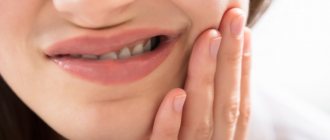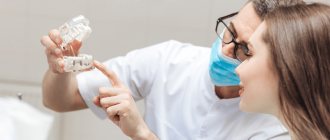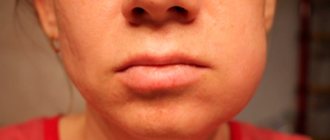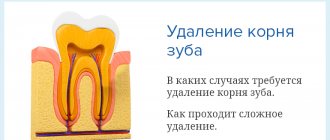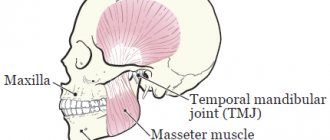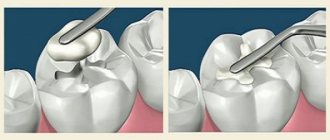1424
Previously, correcting malocclusion began only in adolescence, i.e. when the process of formation of the dentofacial system and active growth of bone tissue was completed.
Today, several methods and designs have been developed in orthodontics that make it possible to correct defects in childhood, and thereby avoid long-term treatment in the future.
One such device is the Forsus device, developed in the USA by 3M UNITEK.
General presentation and purpose
This device belongs to the class of permanent orthodontic devices of mechanical action, which is designed to correct distal occlusion.
The design is used only in conjunction with braces, and is fixed to increase pressure at the last stage of defect correction, when the dentition is formed and crooked teeth are aligned.
The principle of operation is the forced movement of the jaw arches, namely: the lower one forward, and the upper one backward. The lower jaw, however, remains in its place, and surgery to change its position is not performed.
Forsus is effective only for adolescent patients, when the parameters and position of their jaws can be adjusted without surgery.
While wearing, the ligaments and muscles of the jaw stretch very quickly, due to which the correct position of the mandibular joints is created.
The design of the device consists of three parts:
- a retractable set of springs attached to the maxillary first molar by a tube.
- Arch installed on the teeth of the lower jaw.
- mandibular rod sliding along an arc, activating the entire structure. As an additional activation, a clamping stop can also be installed on the rod.
The device is practically invisible in the mouth, quickly fixes, does not break, and does not cause discomfort while wearing, which is so important for teenagers.
Application of Forsus for Class-II correction
The Forsus device is a non-removable spring bite corrector that creates comfort during treatment and allows you to predict its results.
The prefabricated design of the device is durable enough for long-term wearing. When installed on the first premolar, irritation of the oral mucosa or lips is avoided. In this case, the rod of the structure with an elastic ligature and a protective pad is fixed further than the first lower chewing teeth.
The protective cushion installed on the first premolar braces under the arch acts like a shock absorber - it eliminates the tension transferred to the tooth clasp and protects it from the rod. After placing the ligatures, a steel arch is installed, bent below the molars. Next, the bracket installed on the premolar is secured with a metal arch.
A sliding rod installed beyond the first chewing tooth on a small lower jaw or when it is significantly displaced back requires adjustment. This means removing the rod stopper by grinding with abrasive discs. After this, the spring can be distributed along the rod until it bends. Next, you need to reduce the rod to the parameters of a compressed and active spring so that it does not go beyond its limits.
By engaging the first premolar, control of the mandibular incisors is improved. Their undesirable position can be improved by connecting the first posterior teeth to the support of the anterior zone. This is especially necessary for patients with a pronounced posterior displacement of the lower jaw, requiring minimal movements of the lower incisors and forward movement of the lower jaw.
Specifications
Each part of the structure consists of the following elements:
- Anti-rotation shoulder , which prevents movement of the device and the occurrence of unpleasant sensations.
- Rod connecting two correction devices.
- Fatigue resistance, which prevents premature failure of the device.
- Coaxial spring , which provides constant and uniform pressure on the jaw arches and individual elements, and also facilitates opening the mouth.
- Snap-on clip ensures reliable fastening of the structure to the molar.
- A facebow tube that directs pressure to a specific area of the dentition.
Important! The result of testing, which involved dozens of patients, proved the consistency and duration of the effects of Forsus, as well as the absence of discomfort when worn simultaneously with braces.
The final correction of the shape of the dentition and bite is the third stage of orthodontic treatment
The Herbst device was removed after 10 months.
Braces were attached to the teeth where crowns for the Herbst apparatus were installed. Correction of orthodontic treatment was carried out.
The patient continued to wear braces for another year. During this time, the teeth were finally aligned and physiological contacts between opposing teeth were achieved. Observation by the orthodontist continued every 1.5 months.
Indications and contraindications
The main indication for wearing the device is the relationship of the jaw arches according to the distal type. The device is needed to extend the movable jaw and fix it in this position.
Typically, treatment is carried out while wearing braces. In addition to its main purpose, the structure can also be installed to get rid of other problems:
- distalization on the maxillary arch;
- return of the lower jaw to the inside of the oral cavity;
- when closing gaps between teeth to maintain the position of the lower jaw incisors;
- normalization of open bite;
- stretching the upper jaw arch;
- correction of deep occlusion.
As experts note, it is pointless to use the Forsus device in the following conditions:
- asymmetrical crossbite, which involves unilateral enlargement of the jaw;
- open form of anterior occlusion;
- individual units involved in cross-occlusion;
- asymmetry of two or only one jaw;
- weak periodontal tissues.
It is also not recommended to install this device if you have:
- intolerance to the presence of bulky foreign structures in the mouth;
- allergy to metal alloys;
- mental disorders;
- tuberculosis;
- tumor processes in the body, detection of metastases;
- pathological phenomena developing in bone and connective tissues;
- positive HIV status.
Important! The decision to place a corrective structure is made by the doctor based on information obtained from studying the anamnesis, as well as the results of tests and examinations.
For what purpose is the bite height determined and commonly used techniques.
Go here to learn about methods for determining central occlusion.
At this address https://zubovv.ru/ortodontiya/prikus/period-formirovaniya-molochnogo.html we will talk about the features of the milk bite.
Bite correction at the ImplantTime orthodontist
Anna Yuryevna Kopaneva, a doctor with 7 years of experience in orthodontics, will welcome you to our center. She works with malocclusions of any complexity.
- Uses the most advanced braces systems - Damon, 3M, Forestodent, Incognito and WIN lingual braces.
- She has undergone special training to correct malocclusion with transparent aligners (aligners) OrthoSnap, Invisalign.
- Uses Frog, Pendulum, Haas, Quad Helix, Hyrex devices for jaw extension, lengthening, and expansion.
- Performs teeth alignment (uprighting), intrusion and extrusion.
MAKE AN APPOINTMENT
Fixation stages
Among the significant advantages of the device, experts note ease of installation. In practice, all manipulations to place the structure are carried out by the doctor quickly and without any problems.
The order of fastening is as follows:
- Holding the mesial part of the device with Weingard forceps, in the direction from the mesial surface to the distal, the EZII module is inserted into the facebow tube until it clicks. Moreover, the side markings should be on the spring on its distal side.
- The arch bends on the last molar included in the system, thus controlling the position of the elements of the lower row.
- To avoid damage to the ligatures and improve ligation of the brackets, a single metal ligature is used.
- Stupors, for example, the Gurin lock, can limit the contact of the device with braces.
- To expand control over the support of the moving row and prevent protrusion of the frontal zone, all units are connected with one ligature, and a root torque is introduced into the arch in the area of the incisors.
The specialist then proceeds to install the rod and spring. To do this, measure the distance from the distal surface of the canine bracket lock to the distal end of the tube in the center of the occlusion (without taking into account the exit of the mandibular arch).
Using an orthodontic gauge, the desired rod size is selected. Having placed a loop of the rod between the first premolar and the canine, the doctor compresses the spring and places the rod into it. By compressing the loop, it secures the mesial side of the rod around the arch.
Important! If the rod, when closing the jaws in central occlusion, extends beyond the spring, then its size is chosen incorrectly.
Watch the video to see how the Forsus device is installed and operates.
Using the Forsus device to control support during extraction
One of the most common clinical situations that arise during the treatment of class II anomalies is the need for extraction - or removal of premolars - in the presence of mandibular retrognathia. As a rule, indications for the procedure are insufficient free space, as well as protrusion of individual units.
Shifting the lateral areas without correcting the position of the teeth is a difficult task; In addition, the problem is the need to ensure the safety of the upper antagonists during the period of closing the gaps formed after the removal of elements of the series. Mesialization of the maxillary molars and retraction of the lower anterior units can lead to an increase in the sagittal gap, and ultimately negatively affect the results of correction. The use of the Forsus orthodontic corrector provides a sufficient level of control over the position of the elements of both rows, holding them in the correct position, or distalizing them in the intermediate closure phase, and allowing you to adhere to a given treatment protocol.
Duration of wearing
The first result of the correction becomes noticeable very quickly - a change in the state of occlusion for the better can be seen after about 3-4 weeks of wearing the device.
The average duration of treatment is from 4 to 8 weeks. If the design is not used for its intended purpose, for example, to control the support on the upper jaw, then wearing it will naturally be longer.
The duration of bite correction primarily depends on the following factors:
- type and degree of complexity of the defect;
- individual anatomical features of the patient’s dental system;
- condition of bone tissue;
- the speed of tooth movement and changes in the relationship of the jaw arches.
The purpose of distalization of the maxillary molars and the devices used.
In this publication we will talk about the purpose of the hip plane analyzer.
Read here how the Kois deprogrammer improves your bite.
Price issue
The cost depends on the configuration. It can be supplied with a lower vestibular arch with braces (in this case, the price starts from 17,000 rubles), and without an arch (about 10,000 rubles).
Treatment with the device, in addition to its price, includes diagnostics, drawing up a treatment plan, sanitation of the oral cavity, professional cleaning and other therapeutic measures.
The cost of treatment also includes installation of the device, repeated activations, control of the correction process, removal of Forsus after its completion. As a result, the total amount for treatment, depending on the configuration of the device, ranges from 20,000 to 32,000 rubles.
Subtleties of removal
The decision to remove Forsus is made by the doctor after achieving the desired treatment result.
The whole process takes place in the following sequence:
- Compressing the spring, the doctor removes the rod.
- Holding the distal part of the structure with Weingard forceps, the EZ module is removed from the facebow tube in the mesial direction.
- Disconnects the rod by holding its distal end with your fingers and using forceps to unbend the loop at the end of the rod.
Important! Removal, like installation of Forsus, is carried out quickly, without discomfort for the patient.
Where does bite correction begin?
Diagnosis of the problem is important for effective treatment in orthodontics. To do this, our orthodontist:
- examines diagnostic models of the patient’s jaws;
- studies teleradiography and orthopantomography data (x-rays of the skull bones);
- carries out functional diagnostics in the articulator;
- takes a photo protocol (photographs of the face);
- draws up a plan for correcting the bite.
Advantages and disadvantages
The Forsus device is the latest innovation in the development of devices for the correction of Class II anomalies, and compares favorably with all analog designs used in practice.
To confirm this fact, you should consider the advantages of the device:
- High efficiency in correcting distal type of bite.
- No need for surgical intervention.
- Quickly change the profile and shape of the face, as well as the proportions of its parts.
- The soft tissue mucosa is not injured.
- It works automatically and does not require constant supervision by a doctor.
- Installation and removal are quick.
- The treatment result is predictable and achieved in the shortest possible period of wearing.
- No discomfort or pain at all stages of wearing the device.
- The system is not prone to breakdowns, which reduces the number of unplanned visits to the doctor.
- Easy care (similar to care for braces).
- There is no influence on the result of external factors.
In addition, the design can be installed in case of various pathologies with the respiratory system (including if the patient has mouth breathing) and a problem with the enamel coating.
The use of this device is also productive and beneficial in terms of financial costs (if it is included in the correction plan at the initial stage).
Important! None of the existing correction devices can compare with Forsus in terms of reliability, durability, effectiveness, patient satisfaction with the result of correction and ease of placement/removal.
The disadvantages of Forsus include:
- Insufficient aesthetics. Despite the fact that both the manufacturer and many clinics position this device as highly aesthetic, it is still noticeable with a wide smile and active articulation.
- Difficulty in cleaning the last dental elements , which negatively affects the overall level of oral hygiene.
What problems are associated with malocclusion?
Aesthetic
Facial features look disharmonious, there are problems with the attractiveness of a smile.
Functional
The patient cannot chew food normally, which causes digestion to suffer.
Injuries
Teeth located outside the rows injure the mucous membranes or neighbors in the row.
Due to excessive pressure of some teeth on others, they are destroyed and ground down. We can solve these problems with orthodontic treatment methods. In addition, correction of the bite may be necessary before implantation or prosthetics if the teeth in a row interfere with the installation of the prosthesis.
Reviews
Moving the upper jaw back without changing the position of the lower jaw without surgery is the basic principle of the Forsus device.
The conclusions of orthodontists who worked with this design confirm its effectiveness in correcting distal occlusion.
In addition, the device has gained a reputation as a reliable and comfortable system that treats defects in the shortest possible period.
You can share your experience in correcting anomalies of the dentofacial system with this device, or voice your position regarding the effectiveness and feasibility of its installation by leaving a comment on this article.
If you find an error, please select a piece of text and press Ctrl+Enter.
Tags bite alignment devices
Did you like the article? stay tuned
No comments yet
What does the cost consist of:
Diagnostics - free
Bracket system - 14,950 ₽ (for one jaw)
Installation of braces - 20,000 ₽ (for one jaw)
Orthodontic screws - free of charge
Orthodontic plates - free
Monthly payments - 7,000 RUR (for both jaws) Removal + retainer + mouth guard if necessary - 24,000 RUR (for one jaw) Find out more
MAKE AN APPOINTMENT WITH AN ORTHODONTIST For consultation:
✔ Will conduct a thorough comprehensive examination
✔ Will select the optimal bite treatment option that suits you 100%
✔ Will answer all your questions and dispel all your fears
✔ Informs the final cost of treatment, which will not change in the future
Duration of consultation: 30-40 minutes
Call +7 (495) 119-76-32 or leave a request and we will call you back
A correct bite means beautiful, even dentition, harmonious facial features, healthy teeth and gums. will help you get rid of malocclusions of any complexity. We have a highly qualified orthodontist Anna Yuryevna Kopaneva. We provide treatment using the most modern methods and orthodontic instruments: braces, aligners, mouth guards, fixed and removable appliances.
What braces systems do we offer?
BRACES BIOMIM
Metal braces Biomim (USA) with ligatures, which are available in three modifications, which allow you to choose the best option for straightening your teeth. This is an economical and effective correction method with which you can correct bite defects of various types and complexity.
BRACES 3M GEMINI
Durable metal ligature braces from 3M Unitek (USA) with reliable fastening due to a special finely engraved area on each clasp.
Due to the design features, the risk of soft tissue injury is minimal. Our advantages
No hidden fees or increased costs
A unique system of package offers: we guarantee that the cost stated in the treatment plan will not increase
More details
Interest-free installment plan for treatment
Comfortable payment terms without overpayments. Installment plans from leading banks and payment breakdown from the clinic
More details
We use original materials
We use only original products from global manufacturers. We can show all certificates
Installed more than 30,000 implants
The clinic employs only experienced implantologists, each of whom has installed more than 10,000 implants
More details
We issue a passport for each implant installed
Each implant has its own unique serial number; you can check the originality of the product on the official Nobel Biocare website
We provide guarantees for all services
When a patient visits a preventive examination once a year and, accordingly, follows the doctor’s recommendations, we give a lifetime guarantee on all our services
More details
